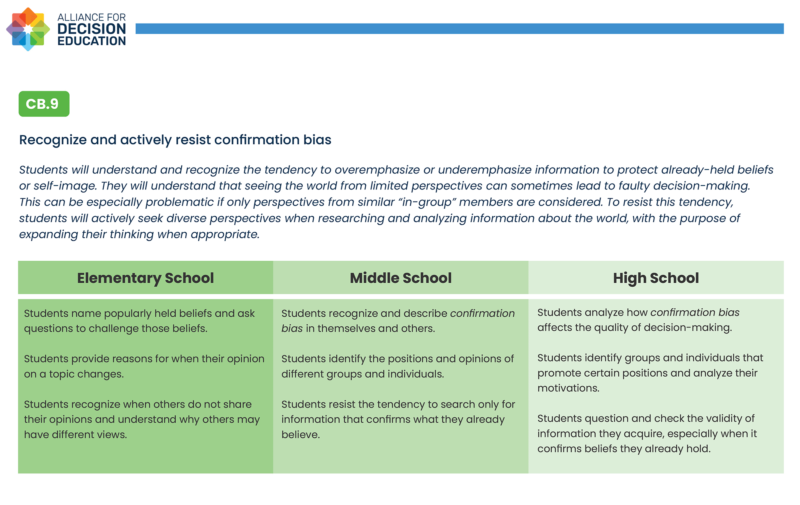The Decision Education K-12 Learning Standards: An Overview

In collaboration with educators and researchers, we are excited to publish the first edition of the Decision Education K-12 Learning Standards.
As we work to ensure that Decision Education is a part of every student’s learning experience, these Standards can provide a comprehensive framework for students to develop effective decision-making skills and dispositions from elementary school through high school.
What are the Learning Standards?
Learning standards, in general, are an outline of what a student should know and be able to do at different levels of their educational career. Standards already exist in schools for a variety of subjects, like reading standards that address how students can progress in reading comprehension, or mathematics standards that outline the different math skills and knowledge students learn over time.
The Decision Education K-12 Learning Standards does just this, but in terms of decision-making skills and dispositions.
For example, the Standards lay out what the progression in recognizing and actively resisting hindsight bias looks like for different age groups. For elementary students, the Standards focus on students being able to identify and describe surprising decision outcomes, and explain how they are different from what they were expecting. For middle school, the Standards highlight how students’ decision-making skills and dispositions should further develop to include being able to assign values to predictions to quantify uncertainty and communicate levels of confidence. When a student reaches high school, the Standards lay out that students should be able to consider potential hindsight bias about their past decisions to inform predictions for current decisions, and rely on tools such as decision trees and decision journals.
Teachers can use the Decision Education K-12 Learning Standards to align their content and classroom practices to ensure their students are learning and developing decision-making skills and dispositions appropriate for their grade level, and prepare students for growth in the years ahead.
How to Read the Learning Standards
Our Standards are organized and color-coded by the four K-12 Learning Domains of Decision Education: Recognizing and Resisting Cognitive Biases, Valuing and Applying Rationality, Thinking Probabilistically, and Structuring Decisions. Within the Learning Domain, we break down each standard, provide details on the decision-making skills captured within that standard, and demonstrate what that skill and knowledge development looks like at the elementary school, middle school, and high school level.
“The Learning Standards can be a great tool for supporting teachers, administrators, and school systems in implementing Decision Education in classrooms,” said Ali Stumacher, Education Senior Manager at the Alliance. “We are excited to continue developing resources that help schools strengthen decision-making skills for students. We encourage everyone to explore the Standards, share with colleagues, and offer feedback to support our work.”
Our hope is that these Standards help to build understanding and demand for Decision Education, not only by schools and educators, but also by parents, policymakers, business leaders, researchers, and the general public.
View the full Decision Education K-12 Learning Standards.

